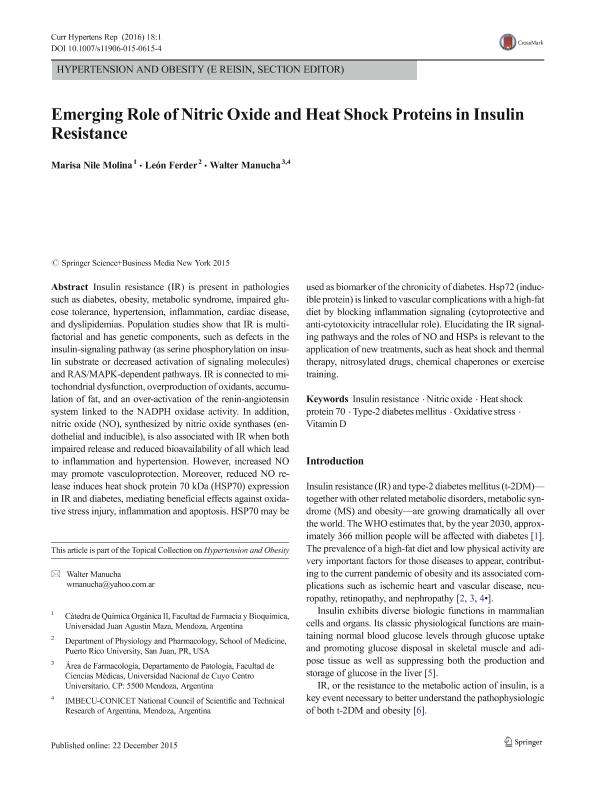Mostrar el registro sencillo del ítem
dc.contributor.author
Molina, Marisa Nile
dc.contributor.author
Ferder, León
dc.contributor.author
Manucha, Walter Ariel Fernando

dc.date.available
2019-07-04T18:15:57Z
dc.date.issued
2016-01
dc.identifier.citation
Molina, Marisa Nile; Ferder, León; Manucha, Walter Ariel Fernando; Emerging Role of Nitric Oxide and Heat Shock Proteins in Insulin Resistance; Springer; Current Hypertension Reports; 18; 1; 1-2016; 1-13
dc.identifier.issn
1522-6417
dc.identifier.uri
http://hdl.handle.net/11336/79151
dc.description.abstract
Insulin resistance (IR) is present in pathologies such as diabetes, obesity, metabolic syndrome, impaired glucose tolerance, hypertension, inflammation, cardiac disease, and dyslipidemias. Population studies show that IR is multifactorial and has genetic components, such as defects in the insulin-signaling pathway (as serine phosphorylation on insulin substrate or decreased activation of signaling molecules) and RAS/MAPK-dependent pathways. IR is connected to mitochondrial dysfunction, overproduction of oxidants, accumulation of fat, and an over-activation of the renin-angiotensin system linked to the NADPH oxidase activity. In addition, nitric oxide (NO), synthesized by nitric oxide synthases (endothelial and inducible), is also associated with IR when both impaired release and reduced bioavailability of all which lead to inflammation and hypertension. However, increased NO may promote vasculoprotection. Moreover, reduced NO release induces heat shock protein 70 kDa (HSP70) expression in IR and diabetes, mediating beneficial effects against oxidative stress injury, inflammation and apoptosis. HSP70 may be used as biomarker of the chronicity of diabetes. Hsp72 (inducible protein) is linked to vascular complications with a high-fat diet by blocking inflammation signaling (cytoprotective and anti-cytotoxicity intracellular role). Elucidating the IR signaling pathways and the roles of NO and HSPs is relevant to the application of new treatments, such as heat shock and thermal therapy, nitrosylated drugs, chemical chaperones or exercise training.
dc.format
application/pdf
dc.language.iso
eng
dc.publisher
Springer

dc.rights
info:eu-repo/semantics/openAccess
dc.rights.uri
https://creativecommons.org/licenses/by-nc-sa/2.5/ar/
dc.subject
Heat Shock Protein 70
dc.subject
Insulin Resistance
dc.subject
Nitric Oxide
dc.subject
Oxidative Stress
dc.subject
Type-2 Diabetes Mellitus
dc.subject
Vitamin D
dc.subject.classification
Salud Ocupacional

dc.subject.classification
Ciencias de la Salud

dc.subject.classification
CIENCIAS MÉDICAS Y DE LA SALUD

dc.title
Emerging Role of Nitric Oxide and Heat Shock Proteins in Insulin Resistance
dc.type
info:eu-repo/semantics/article
dc.type
info:ar-repo/semantics/artículo
dc.type
info:eu-repo/semantics/publishedVersion
dc.date.updated
2019-06-11T15:21:03Z
dc.journal.volume
18
dc.journal.number
1
dc.journal.pagination
1-13
dc.journal.pais
Estados Unidos

dc.journal.ciudad
Nueva York
dc.description.fil
Fil: Molina, Marisa Nile. Universidad "Juan Agustín Maza". Facultad de Farmacia y Bioquímica; Argentina
dc.description.fil
Fil: Ferder, León. Universidad de Puerto Rico; Puerto Rico
dc.description.fil
Fil: Manucha, Walter Ariel Fernando. Consejo Nacional de Investigaciones Científicas y Técnicas. Centro Científico Tecnológico Conicet - Mendoza. Instituto de Medicina y Biología Experimental de Cuyo; Argentina. Universidad Nacional de Cuyo. Facultad de Ciencias Médicas; Argentina
dc.journal.title
Current Hypertension Reports

dc.relation.alternativeid
info:eu-repo/semantics/altIdentifier/url/http://link.springer.com/article/10.1007/s11906-015-0615-4
dc.relation.alternativeid
info:eu-repo/semantics/altIdentifier/doi/http://dx.doi.org/10.1007/s11906-015-0615-4
Archivos asociados
